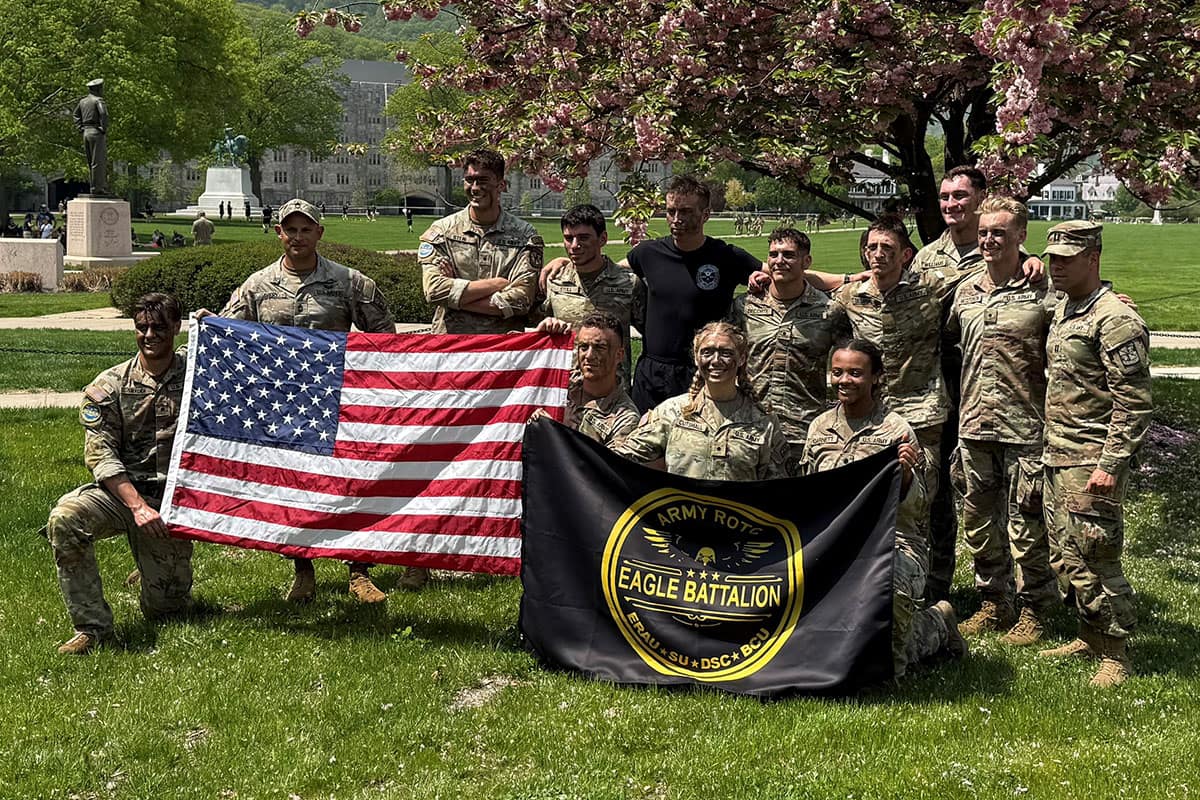Embry-Riddle Army ROTC Finishes Strong at Military Skills Competition, and Cadet Delivers Life-Saving Aid

During the recent 2025 Sandhurst Military Skills Competition, an Embry-Riddle Aeronautical University Army ROTC cadet provided life-saving assistance to a Mexican cadet who collapsed from heat exhaustion amid an eight-mile rucksack march.
“In my mind, I just did the right thing and what I signed up to do,” said Cadet Barrett Cutshall, who was trained as a combat medic in the National Guard. “That’s why I wanted to be a combat medic, because I never want to be in a situation where I can’t help someone.”
The Sandhurst Competition is a rigorous two-day event where cadets compete in 14 demanding challenges over a 30-mile course. Participants are tested on a range of skills, including weapons assembly, medical evacuation, land navigation, marksmanship and physical endurance.
At the 2025 Sandhurst Competition, Embry-Riddle’s Army ROTC Eagle Battalion secured 4th place among U.S. Army ROTC teams and 17th overall out of 48 teams worldwide. The competition was held in early May at the U.S. Military Academy in West Point, New York.
"The preparation, the hard work and the dedication these cadets put into training truly paid off,” said Master Sgt. Jonathan Avery, senior Military Science instructor and coach. “Their strong showing is a reflection of their relentless effort and commitment to excellence."
Eagle Battalion finished among the top five U.S. teams for the second consecutive year.
"I couldn't be more proud of how our cadets represented our program, Embry-Riddle Aeronautical University and the 6th Brigade,” said Lt. Col. Jerome Reitano, professor of Military Science at Embry-Riddle. “This underscores its growing reputation for excellence in military leadership and training.”

Eagle Battalion Cadet Barrett Cutshall with cadets from the Mexico team after she was presented with a coin for helping to save the life of one of their teammates who collapsed from heat exhaustion amid Sandhurst’s eight-mile ruck march. (Photo: Embry-Riddle/ERAU Army ROTC)
Cadet Provides Life-Saving Aid
This year was the first time that Cutshall, a junior Aerospace Physiology major from New Cumberland, Pennsylvania, had participated in Sandhurst. She was about six miles into the eight-mile ruck march event when she heard someone call for a medic and saw German and Polish teams gathered around a Mexican cadet who had collapsed from heat exhaustion.
“He was very pale, clammy and unconscious,” said Cutshall. “He was clearly in shock. It looked very bad.”
She helped move the fallen cadet into a recovery position. When a medical crew arrived on an ATV, she assisted in preparing an IV bag, taking his vitals and monitoring him until he was transported to the hospital.
"When faced with a situation like that, I was proud that Cadet Cutshall realized the competition was secondary to the health and welfare of a fellow competitor,” said Reitano. “There is no greater pride than seeing your cadets embody values we strive to instill — selflessness, courage and leadership."
Cadet Cutshall was recognized for her heroic actions “with challenge coins from multiple brigade commanders as well as the commanding general of U.S. Army Cadet Command,” Reitano said. “She also received a coin and patch from the Mexico team for her pivotal role in helping their teammate and friend.”
Cutshall was also recognized by Embry-Riddle President P. Barry Butler, Ph.D., upon her return to the Daytona Beach Campus.
Cutshall has served in the National Guard for five years, and she eventually hopes to serve as an infantry officer in the U.S. Army and earn her master’s degree in Human Factors. This summer, she will attend two weeks of air assault training in Hawaii and five weeks of advanced cadet camp training at Fort Knox in Kentucky.

 Melanie Stawicki Azam
Melanie Stawicki Azam